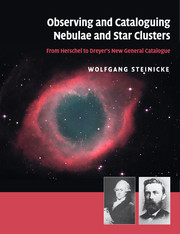Book contents
- Frontmatter
- Contents
- Preface
- 1 Introduction
- 2 William Herschel's observations and parallel activities
- 3 John Herschel's Slough observations
- 4 Discoveries made in parallel with John Herschel's Slough observations
- 5 John Herschel at the Cape of Good Hope
- 6 The time after Herschel's observations until Auwers' list of new nebulae
- 7 Compiling the General Catalogue
- 8 Dreyer's first catalogue: the supplement to Herschel's General Catalogue
- 9 Compilation of the New General Catalogue
- 10 The New General Catalogue: publication, analysis and effects
- 11 Special topics
- 12 Summary
- Appendix
- References
- Internet and image sources
- Name index
- Site index
- Object index
- Subject index
7 - Compiling the General Catalogue
Published online by Cambridge University Press: 06 December 2010
- Frontmatter
- Contents
- Preface
- 1 Introduction
- 2 William Herschel's observations and parallel activities
- 3 John Herschel's Slough observations
- 4 Discoveries made in parallel with John Herschel's Slough observations
- 5 John Herschel at the Cape of Good Hope
- 6 The time after Herschel's observations until Auwers' list of new nebulae
- 7 Compiling the General Catalogue
- 8 Dreyer's first catalogue: the supplement to Herschel's General Catalogue
- 9 Compilation of the New General Catalogue
- 10 The New General Catalogue: publication, analysis and effects
- 11 Special topics
- 12 Summary
- Appendix
- References
- Internet and image sources
- Name index
- Site index
- Object index
- Subject index
Summary
John Herschel's ‘Catalogue of nebulae and clusters of stars’ – commonly known as the General Catalogue (GC) – was published in 1864 in Vol. 154, Part I, of the Philosophical Transactions of the Royal Society (Herschel J. 1864). At that time Herschel was already 71. After years of low astronomical activity, he had decided to collect all known nebulae and star clusters in a common catalogue. The work started in about 1859 and was finished on 23 June 1863. This date refers to the main catalogue; the added ‘Supplementary list’ was not made until October 1863. Later in 1864a hardcover version was published by Taylor and Francis, London. The GC differs from Herschel's earlier Slough and Cape catalogues (SC and CC), which mainly contain data based on his own observations. In the case of the SC (1833) his goal was a re-examination of the objects contained in the catalogues of his father, using Caroline Herschel's reduction. The CC (1847) lists, with the exception of Dunlop's objects, mainly his own southern-sky discoveries. On the other hand, the GC presents all non-stellar objects found by 1863 for both hemispheres – therefore, it is a ‘database’ in the modern sense. As shown in the following sections, the General Catalogue lists many new objects.
- Type
- Chapter
- Information
- Observing and Cataloguing Nebulae and Star ClustersFrom Herschel to Dreyer's New General Catalogue, pp. 188 - 224Publisher: Cambridge University PressPrint publication year: 2010



